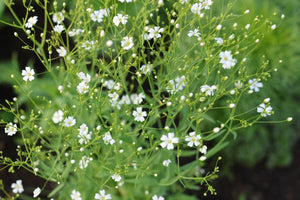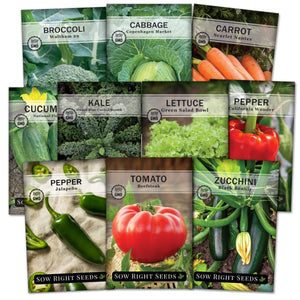Top 10 Easiest Vegetables to Grow from Seed
Beginner gardeningWe love growing from seed and encourage gardeners of all skill levels to start their vegetables, herbs, and flowers from seed. Growing vegetables from seed will give you a wide variety to choose from. And you’ll enjoy the garden-fresh flavor that is unmatched. We’ve got 10 easy vegetables to grow from seed so anyone can enjoy a successful harvest of delicious, healthy food.

The seeds that made our list of easiest vegetables to grow are ones that will easily germinate without special care, such as scarification or stratification. These vegetables are also simple to grow and will have a reliable harvest.
All of these vegetables can be planted outdoors without starting indoors. (Except for microgreens, which you will harvest indoors!) Direct sowing seeds outdoors can simplify gardening for beginners.
If you want to learn more about starting seeds indoors, our complete guide will help you get started.
And if you need some extra motivation, read this post on Why You Should Be Growing from Seed.
The 10 Easiest Vegetables to Start Growing from Seed

#1 - Lettuce
Lettuce is the #1 vegetable we recommend to new gardeners. Within six weeks of planting, you can be eating a fresh, crisp lettuce leaf. Lettuce seeds are quick to germinate, and there are many different heirloom varieties. The wide range of colors, textures, and flavors is an excellent reason to grow lettuce from seed. Our All-the-Year Round variety is an excellent choice for beginner gardeners.
You can start lettuce seeds indoors and then transplant seedlings outdoors. But the easiest way to grow lettuce is to plant seeds outdoors in early spring or fall.

#2 - Beans
Plant beans if you want a bountiful harvest your first year growing from seed! From one bean seed, you can grow a plant that will produce enough beans for several meals.
Beans are easy to direct sow and are adaptable to different kinds of soil. They will sprout quickly, and in only seven days, a small bean sprout will push through the soil.
There are many heirloom varieties to choose from in both vine and bush bean types. Bush beans like Contender are reliable producers. And the Royal Burgundy has beautiful color.
Learn more about growing beans and how they can even improve your garden soil.

#3 - Swiss Chard
Swiss chard seeds will easily germinate and quickly grow. This healthy vegetable grows well in containers and can be grown on a balcony. You don’t have to wait for the leaves to get large to harvest. The small leaves at around 3 inches are tender and sweet.
Start Swiss chard seeds indoors or outside as long as the temperature is about 50ºF for seed germination. Rainbow Swiss chard is both beautiful and easy to grow. Add it to your containers or raised beds for a beautiful, edible landscape.

#4 - Radishes
Radishes are excellent to start when you have cool weather and are anxious to get something in the ground. They’ll begin sprouting about six days after they are planted, and you can be eating them in 25 days. Your radishes can be tucked in with other spring vegetables or harvested before you put out your summer plants.
You could plant several kinds of different heirloom radish varieties and find your new favorite. Try the Easter Egg mix for perfectly round radishes in pink, purple, and white shades. French Breakfast radishes are mild, and the Watermelon variety has a surprise interior.

#5 - Peas
Peas are another one of those plants to get going in the early spring.
When you’re tired of the cold and snow, you can plant peas as soon as the soil is no longer frozen. They are easy to grow from seed, and Sugar snap peas are perfect for beginner gardeners. Their fresh taste will convince you that you love gardening.
Peas eaten fresh from the vine are full of vitamins and natural sugar. But they start turning from sugar to starch as soon as they are picked. This is why you need to grow them in your garden.
Also, peas add nitrogen back into the soil, so they’re great to plant before you add your summer vegetables, like tomatoes and eggplant.

#6 - Cucumbers
Cucumbers are incredibly easy to grow from seed. I’ve even had them grow on their own where seeds fell between garden boxes.
Cucumber seeds are adaptable to starting indoors or direct sowing and will germinate in 7 days.
Cucumbers are a delicious summer vegetable. There are many varieties of heirloom cucumbers, from standard pickling cucumbers to uniquely lemon-shaped cucumbers. The range of colors and shapes will keep your garden from being boring.

#7- Zucchini and Summer Squash
Zucchini is a famous home garden vegetable for good reason. It is very easy to sow from seed and grows all summer long. Once the ground is warm enough, you can plant zucchini and summer squash seeds directly in the garden. The seeds will sprout and grow quickly. Harvest zucchini and summer squash while they are still small for a more tender texture and better flavor.
Add variety to your zucchini garden with unique heirloom varieties. Golden zucchini, round zucchini, and grey zucchini are all equally delicious. Summer squash grows like zucchini with some flavor and texture differences. Learn how easy it is to grow zucchini in your garden.

#8 - Beets
Beets are an easy vegetable to grow from seed because they germinate quickly. You will see little sprouts pushing up from the ground in as little as five days. Also, beet seeds are prolific because each seed you plant is actually a seed pod with several seeds.
Before the roots are ready to eat, you can pick beet greens and eat them raw or cooked. Just leave enough on the plant so it has enough energy-gathering surfaces for root development. Once they are planted in fertile garden soil, they don't require extra maintenance.
The health benefits of beets make them a popular garden staple, and they come in a range of colors. And if you’re looking for a slightly different flavor, try golden globe beets.

#9 - Peppers
Peppers don’t always make the list of easiest vegetables to grow from seed. But once you know they need heat to germinate, there’s no reason not to start growing peppers. You can start seeds indoors or wait until it’s warm enough outside.
Hot peppers like Jalapeños are some of the easiest to grow and are very prolific. They don’t have problems with pests and diseases and love the hot summer sun.
Growing heirloom peppers from seed gives you many options for flavor and heat. Hot peppers range from a Scoville Heat Unit of 100 to over 300,000. Banana peppers are the mildest, and our Habanero Red are our hottest. Cayenne peppers also make a beautiful edible ornamental plant in containers.

#10 - Microgreens
There can’t be anything easier than growing microgreens! These tiny vegetables can be harvested in a matter of days. They don’t need much light and can be grown indoors. If you want access to fresh-tasting vegetables all year round, grow microgreens. You can try a variety of flavors, such as broccoli, cabbage, peas, and more.
Our microgreen kits come with everything you need to start growing.
You may have noticed some popular vegetables didn’t make our list. Although we love growing tomatoes, starting tomatoes from seed can take some extra care, especially for those with short growing seasons. But we have excellent information on growing tomatoes, and following these guides will help you be a successful tomato grower.
Gardening doesn’t need to be complicated. With so many options to choose from, we recommend starting with the easiest vegetables to grow. This list of our top 10 seeds will get you started. Start growing your vegetables from seed and see how easy and deliciously rewarding a home garden can be.
Written by Beverly Laudie
Found this information helpful? Share it with your gardening friends!





Leave a comment